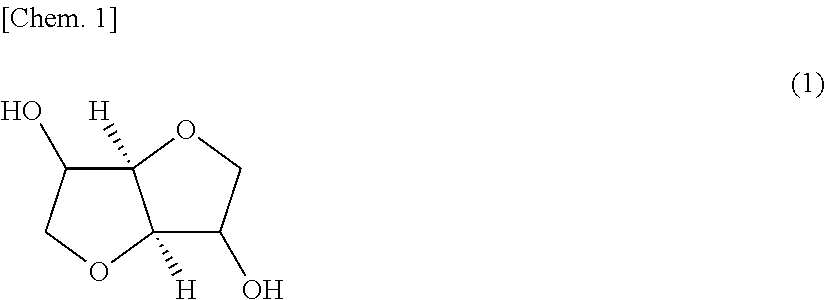Sheet for card, and card
a card and card body technology, applied in the field of card body and card body, can solve the problems of poor card appearance, large card embossing curl, difficult to insert the card into the reader/writer, etc., and achieve the effects of improving the impact resistance of polycarbonate resin, excellent heat resistance, weatherability, punchability and embossability
- Summary
- Abstract
- Description
- Claims
- Application Information
AI Technical Summary
Benefits of technology
Problems solved by technology
Method used
Image
Examples
examples
[0135]The invention will be explained below in more detail by reference to Examples, but the invention should not be construed as being limited to the following Examples.
first embodiment
Examples of the First Embodiment
[0136]The methods used for determining or evaluating various measured values and evaluation are as follows.
(1) Heat Resistance (Glass Transition Temperature)
[0137]The sheet for cards produced in each Production Example was subjected as a sample to an examination of the temperature dispersion of dynamic viscoelasticity which was made under the conditions of a strain of 0.1%, a frequency of 10 Hz, and a heating rate of 3° C. / min (examination of dynamic viscoelasticity in accordance with JIS-K7198 Method A (1991)) using viscoelasticity spectrometer DVA-200 (manufactured by IT Keisoku Seigyo K.K.). The temperature at which the loss tangent (tan θ) showed a main-dispersion peak was taken as the glass transition temperature.
(2) Weatherability (Color Difference ΔYI)
[0138]Using Eye Super UV Tester SUV-W151 (manufactured by Iwasaki Electric Co., Ltd.) as a tester, UV was irradiated upon the sheet for cards, as a sample, produced in each Production Example, und...
production example 1
[0141]A polycarbonate resin which included structural units derived from isosorbide and structural units derived from 1,4-cyclohexanedimethanol in a former-to-latter ratio of 40:60 (% by mole) was kneaded at 220° C. using a 40-mmΦ corotating twin-screw extruder and then extruded through a T-die. Subsequently, the extrudate was rapidly cooled with an 80° C. casting roll and, simultaneously therewith, the surface on the reverse side from the surface in contact with the casting roll was brought into contact with a matting roll to mat the surface. Thus, an overlay sheet for cards (A-1) which had a thickness of 100 μm was produced. The matted surface had a 10-point average roughness of 15 μm.
PUM
| Property | Measurement | Unit |
|---|---|---|
| glass transition temperature | aaaaa | aaaaa |
| glass transition temperature | aaaaa | aaaaa |
| roughness | aaaaa | aaaaa |
Abstract
Description
Claims
Application Information
 Login to View More
Login to View More - R&D
- Intellectual Property
- Life Sciences
- Materials
- Tech Scout
- Unparalleled Data Quality
- Higher Quality Content
- 60% Fewer Hallucinations
Browse by: Latest US Patents, China's latest patents, Technical Efficacy Thesaurus, Application Domain, Technology Topic, Popular Technical Reports.
© 2025 PatSnap. All rights reserved.Legal|Privacy policy|Modern Slavery Act Transparency Statement|Sitemap|About US| Contact US: help@patsnap.com



